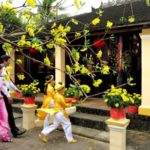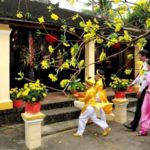According to Vietnamese tradition, at the end of the year, Vietnamese families start to gather and prepare a special meal, considered the last meal of the year, to welcome the new year.
This meal is quite simple and does not need to be elaborate. The host family only needs to prepare it with sincerity. Let’s explore the New Year’s Eve dinner and the New Year’s Eve prayer together!
1 New Year’s Eve Ceremony Timing for Giáp Thìn 2024
When is the best time to hold the New Year’s Eve ceremony?
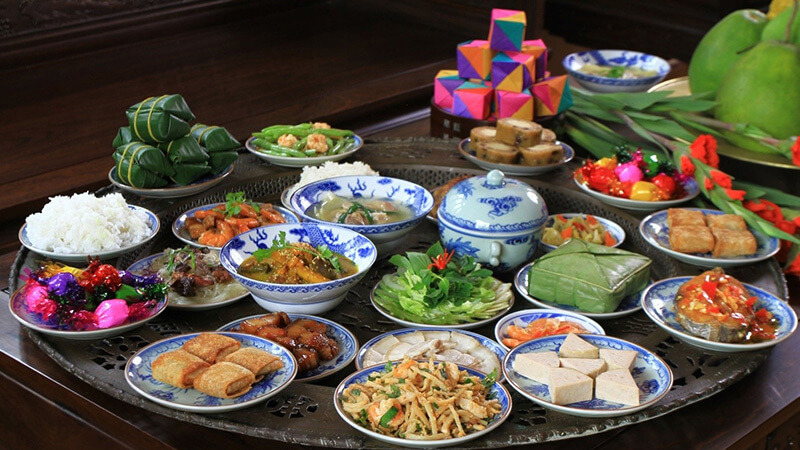 Timing for New Year’s Eve Ceremony
Timing for New Year’s Eve Ceremony
The New Year’s Eve ceremony can be held on the 30th of Chạp if it is a leap year and on the 29th of Chạp if it is a common year. The ceremony usually takes place in the afternoon or early evening.
However, in recent years, many families have started to hold the New Year’s Eve ceremony earlier, which means it does not necessarily have to be on the 30th or 29th of Tết, but it can be earlier.
What is the most auspicious time for the New Year’s Eve ceremony?
The New Year’s Eve ceremony is usually held in the early evening of the 30th of Tết (for a leap year). This year is a leap year, so families will hold the New Year’s Eve ceremony on the 30th of Tết. According to experts, the following are auspicious dates and times to choose from for the New Year’s Eve ceremony at home or in the office:
- 26th of Chạp (5th of February, 2024, in the Gregorian calendar), which is the day of Kỷ Hợi, the month of Ất Sửu, and the year of Quý Mão. Auspicious hours on the 26th of Chạp: Ất Sửu (1am-3am), Mậu Thìn (7am-9am), Canh Ngọ (11am-1pm), Tân Mùi (1pm-3pm), Giáp Tuất (7pm-9pm), Ất Hợi (9pm-11pm).
- 29th of Chạp (9th of February, 2024, in the Gregorian calendar), which is the day of Nhâm Dần, the month of Ất Sửu, and the year of Quý Mão. Auspicious hours on the 29th of Chạp: Canh Tý (11pm-1am), Tân Sửu (1am-3am), Giáp Thìn (7am-9am), Ất Tị (9am-11am), Đinh Mùi (1pm-3pm), Canh Tuất (7pm-9pm).
- 30th of Chạp (9th of February, 2024, in the Gregorian calendar), which is the day of Quý Mão, the month of Ất Sửu, and the year of Quý Mão. Auspicious hours on New Year’s Eve: Nhâm Tý (11pm-1am), Giáp Dần (3am-5am): Thanh Long, Ất Mão (5am-7am), Mậu Ngọ (11am-1pm), Kỷ Mùi (1pm-3pm), Tân Dậu (5pm-7pm)
Basically, the New Year’s Eve ceremony, regardless of the timing, only holds the meaning of welcoming the Kitchen God and ancestors back home to celebrate the new year with their descendants, symbolizing the reunion and warmth of the family. However, it is best to hold the ceremony on the last day of the year to follow the traditional customs passed down by our ancestors.
2 What to Prepare for the New Year’s Eve Ceremony?
New Year’s Eve Ceremony in Northern Vietnam
In Northern Vietnam, the New Year’s Eve ceremony must include; 4 bowls and 4 plates (for a small offering tray); or 6 bowls and 6 plates, or 8 bowls and 8 plates (for a larger offering tray). Some families may even prepare a three-tiered offering tray.
- Four bowls include: Braised pig’s trotters with bamboo shoots and pork tongue, fish balls, glass noodles, and pork meatballs.
- Four plates include: Vietnamese pork sausage (giò lụa), cinnamon pork sausage (chả quế), chicken, and pork.
New Year’s Eve Ceremony in Central and Southern Vietnam
In Central Vietnam, the New Year’s Eve ceremony is similar to that of Northern and Southern Vietnam, where families are busy preparing and offering food. Typically, the offering tray in Central Vietnam does not require a specific number of dishes like in Northern Vietnam, but it includes special dishes such as: Vietnamese pork sausage (giò lụa), chicken, pork, dried bamboo shoots, and stir-fried glass noodles.
In Southern Vietnam, the New Year’s Eve offering tray often includes cylindrical glutinous rice cakes (bánh tét), bamboo shoot soup, braised pork and eggs (thịt kho tàu), fried spring rolls (chả giò), spring rolls (nem), and shrimp and pork salad (gỏi tôm thịt). Additionally, people in the South usually prefer cold dishes.
Essential dishes include: cylindrical glutinous rice cakes (bánh tét), pickled radish in fish sauce, bamboo shoot soup, bitter melon stuffed with pork (khổ qua nhồi thịt), braised pork and eggs (thịt kho tàu), shrimp and pork salad (gỏi tôm thịt), boiled pork, pickled beansprouts, spring rolls (nem), fried spring rolls (chả giò), and pickled onions… to offer to their ancestors.
 New Year’s Eve Offering Tray
New Year’s Eve Offering Tray
For reference:
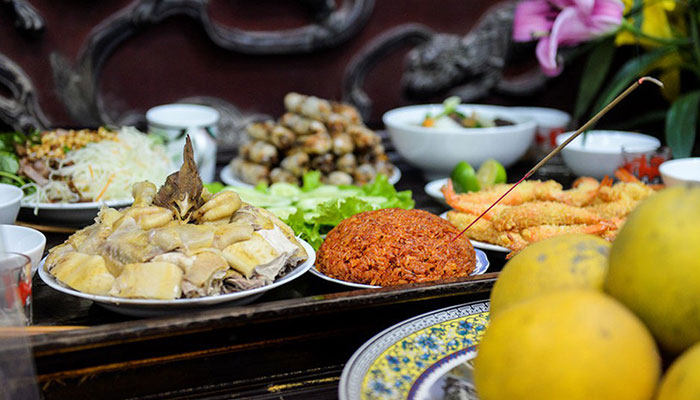
3 New Year’s Eve Prayer for Giáp Thìn 2024
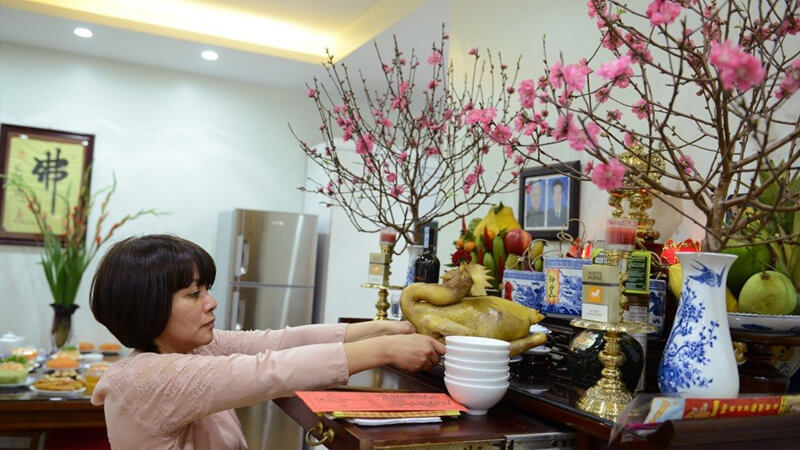 New Year’s Eve Prayer
New Year’s Eve Prayer
The standard New Year’s Eve prayer has been recorded in cultural documents. The following is a prayer excerpted from Ancient Vietnamese Prayers – Published by Culture and Information Publishing House.
For reference: the standard prayer for the 30th of Tết, Giáp Thìn 2024
Nam Mô A Di Đà Phật! (3 times)
– We respectfully bow to the nine directions of the sky and the ten directions of the Buddha, the Buddha of the ten directions.
– We respectfully bow to the Emperor of Heaven, the Goddess of the Earth, and the noble gods.
– We respectfully bow to the noble god of the current year, the Thái Tuế.
– We respectfully bow to the noble gods of the local land and the Thành hoàng gods.
– We respectfully bow to the local gods, the Thổ địa gods.
– We respectfully bow to the gods of the five directions, the five soils, the dragon veins, the Tài thần, the Táo quân of the family, and all the other noble gods who govern this land.
– We respectfully bow to our noble ancestors, the Cao Tằng Tổ Khảo, the Cao Tằng Tổ Tỷ, and the Tiên linh of our family, both internal and external relatives…
Today is the 30th of Chạp of the year …
We, the believers, are: …
Living at…
Before the altar, we respectfully inform: The end of the year is approaching, and the new year is about to begin. We, along with our entire family, have prepared offerings of incense, flowers, food, and drinks for the New Year’s Eve ceremony to offer to the gods and our ancestors and to commemorate our beloved ancestors.
Following the annual tradition of the New Year’s Eve ceremony, we humbly invite the noble gods, our beloved ancestors, the local gods, and all the spirits to descend and witness our offerings, accept our offerings, and bless our entire family, young and old, with peace, prosperity, good fortune, and health. We sincerely invite you to witness and protect us.
Nam Mô A-di-đà Phật (3 times, 3 bows).
4 Notes for the New Year’s Eve Ceremony
Similar to other ceremonies throughout the year, the New Year’s Eve ceremony does not need to be too formal, but the host family should pay attention to the following:
 Notes for the New Year’s Eve Ceremony
Notes for the New Year’s Eve Ceremony
- Although the New Year’s Eve ceremony does not need to be too elaborate or formal, it also should not be taken lightly. Depending on the family’s circumstances, the host family can prepare a smaller or larger offering tray, but it must include traditional New Year dishes and be prepared and presented neatly and cleanly.
- To ensure a solemn and respectful New Year’s Eve ceremony, the host family should clean the altar and the house thoroughly before the ceremony.
- The New Year’s Eve ceremony is a reunion dinner for the family, so all family members should be present to showcase the family’s unity and warmth.
- The New Year’s Eve ceremony is a time for families to reunite and gather after a year of hard work, especially for families with children who live and work far from home. Therefore, arguments and scolding should be avoided, and instead, joyful and positive conversations should be encouraged.
5 Related Questions
Should the New Year’s Eve ceremony be held indoors or outdoors?
According to cultural experts, the New Year’s Eve ceremony is usually held at the family altar for worshipping ancestors and gods. Before the ceremony, families typically clean and rearrange the altar to make it neat and tidy.
On the day of the New Year’s Eve ceremony, all family members gather to cook and offer the last meal of the year to the gods and ancestors. If the family is well-off, they may also hold an additional ceremony outdoors, but this is not mandatory.
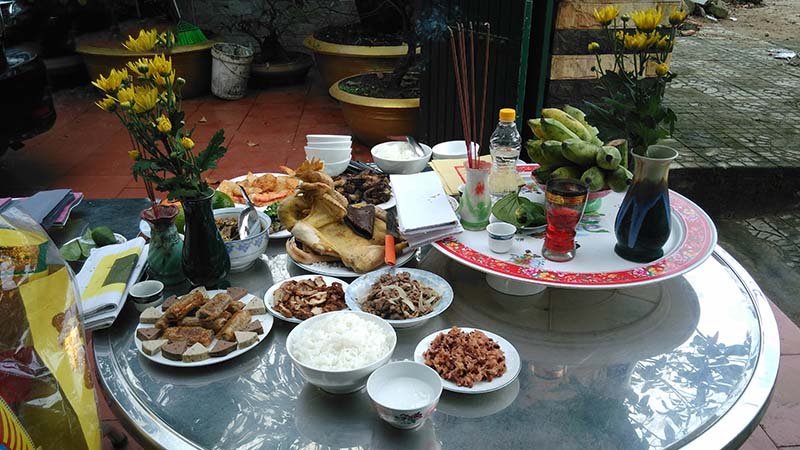 Indoor or Outdoor New Year’s Eve Ceremony?
Indoor or Outdoor New Year’s Eve Ceremony?
Should the New Year’s Eve offering tray be vegetarian or non-vegetarian?
In reality, whether to offer vegetarian or non-vegetarian food during the New Year’s Eve ceremony depends on the cultural and religious beliefs of each family and region. Buddhist families will offer vegetarian food. For non-Buddhist families, both vegetarian and non-vegetarian dishes, including sweet, stir-fried, and fried dishes, can be offered.
However, whether the offering tray is vegetarian or non-vegetarian, simple or elaborate, the most important thing is to maintain sincerity and gratitude towards the ancestors. Therefore, these points should be considered when planning the menu for the New Year’s Eve ceremony.
Here are some suggestions for vegetarian dishes:
- Stir-fried noodles with vegetarian ham
- Xoi (sticky rice) with lotus seeds
- Stir-fried mustard greens with wood ear mushrooms
- Green papaya and peanut salad
- Vegetarian spring rolls
- Stir-fried glass noodles with vegetables
- Mushroom and tofu soup
- Sour soup
What is included in the New Year’s Eve ceremony?
Incense and candles: These are essential offerings for the New Year’s Eve ceremony. If there is no light available, the host family can use candles as a substitute. Additionally, the family should place two candles or two lamps on both sides of the altar to symbolize the sun and the moon.
Tray of five fruits: This is a must-have for the New Year’s Eve ceremony. Therefore, when choosing the fruits, the family should select fresh, ripe, and attractive fruits and avoid using artificial fruits.
Furthermore, Buddhist families should not place the tray of five fruits in the center of the incense burner. According to spiritual beliefs, placing the tray in this position will block the central axis of energy. Instead, it should be placed beside the incense burner. Additionally, when offering flowers to the ancestors, artificial flowers should not be used.
The New Year’s Eve ceremony marks a reunion dinner for the family, welcoming the Kitchen God and inviting the ancestors to celebrate the new year together. This is considered a beautiful custom of our nation, and today, families still uphold and prepare for this ceremony meticulously.

























